Agriculture Reference
In-Depth Information
Mobile water
C
m
S
e
m
S
k
m
S
i
m
Dynamic region
C
m
C
m
Total sites =
S
max
C
im
C
im
Stagnant region
S
im
S
im
S
im
C
im
Immobile water
FIGURE 8.17
Schematic diagram of a modified mobile-immobile (two-region) concept. (From H. M. Selim
and M. C. Amacher. 1997.
Reactivity and Transport of Heavy Metals in Soils
. Boca Raton, FL: CRC
Press. With permission.)
(1988) used
k
1
,
k
2
, and
k
s
values from a three-parameter version of the second-
order model described earlier. Predicted BTCs were obtained using differ-
ent sets of batch rate coefficients due to their strong dependence on input
concentrations (
C
o
). Closest predictions to experimental Cr(VI) measure-
ments were obtained from batch rate coefficients at low
C
o
values (
C
o
< 10 mg
L
-1
). Moreover, the use of rate coefficients at higher values of
C
o
resulted in
decreased tailing and reduced retardation of the BTCs. These observations
are consistent with the second-order two-site approach discussed in the pre-
vious chapter. Overall, predictions of measured Cr(VI) using this model may
be considered adequate. However, it is conceivable that a set of applicable
rate coefficients over the concentration range for Cr(VI) transport experi-
ments cannot be obtained simply by use of the batch procedure described
in this study. In addition, several parameters used in model calculations
were estimated and not measured, for example, Θ
m
, α, and
D
. The fraction
of active sites
f
was not estimated; rather it was assumed equal to the mobile
water fraction (Θ
m
/Θ). Amacher and Selim (1988) argued that it is likely that
improved model predictions could be obtained if such parameters could be
measured independently. They also postulated that other possible factors
responsible for these predictions may be due in part to lack of nonequilib-
rium conditions between the mobile and immobile fractions (Valocchi, 1985;
Parker and Valocchi, 1986).

Search WWH ::

Custom Search